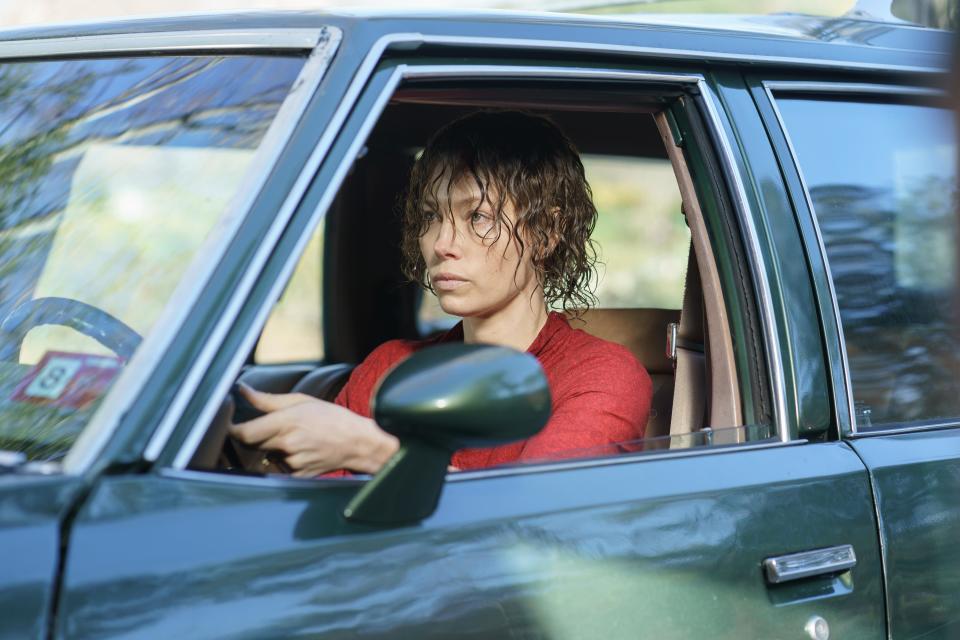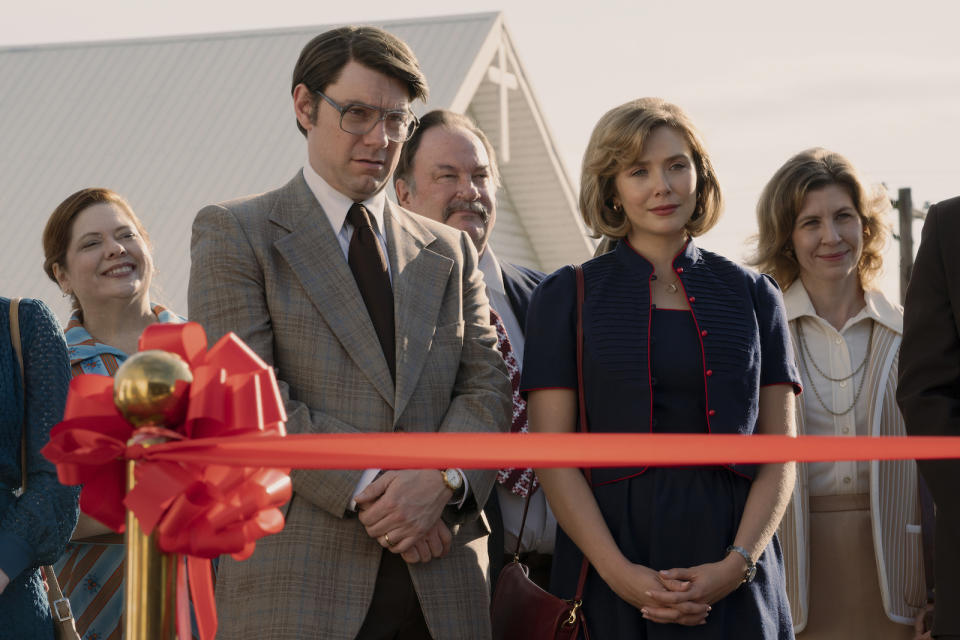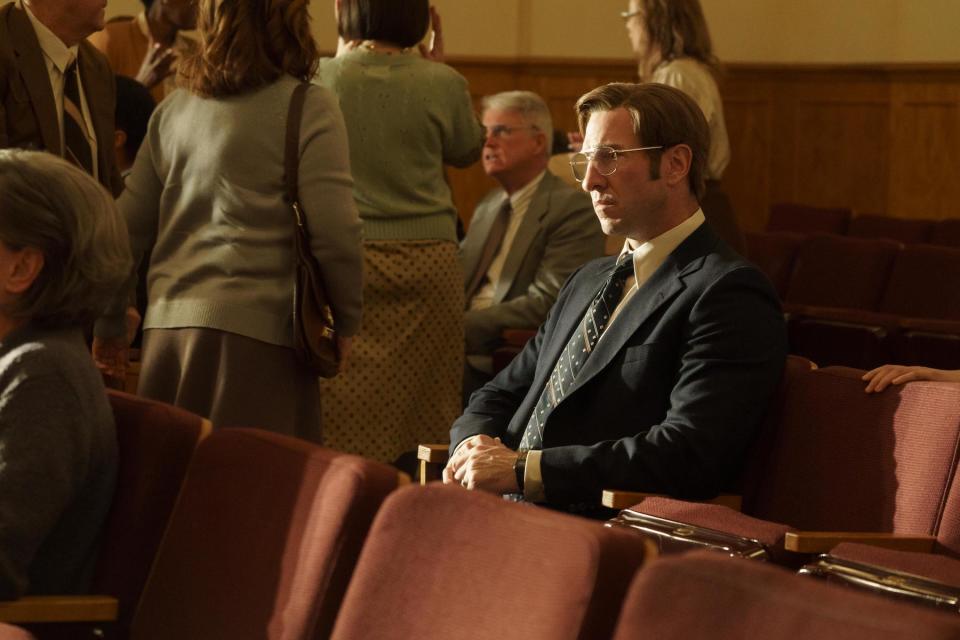In ‘Love & Death’ and ‘Candy,’ the True Story Doesn’t Always Provide the Truth

- Oops!Something went wrong.Please try again later.
Betty Gore died on June 13, 1980. Her church friend Candy Montgomery swung the axe that killed her. Those facts form the basis for two TV shows released in the past 12 months: HBO Max’s “Love & Death” starring Elizabeth Olsen and Hulu’s “Candy” with Jessica Biel. Both are set in Wylie, Texas before and after the attack; both try to understand the events that shook the town.
Yet very early on, “Love & Death” locks in the difference in their ambitions with a disclaimer: “This is a true story.” The five words at the top of every episode might be a subtle jab at other interpretations; it could be a device designed to keep HBO Max subscribers’ attention. It’s definitely a declaration of intent. Where “Candy” addresses the levels of rationalization of which people are capable, “Love & Death” ticks more boxes on the “true story” checklist.
More from IndieWire
“Candy” uses a notable case to unpack what it means to have someone else tell the story of a woman’s death. It frames the aftermath of Betty’s murder as a slow-motion horror story, with people not quite in control of their own decisions and left to the mercy of their own impulses.
In contrast, “Love & Death” plays out closer to a dramatized version of a rundown of events you’d hear one person tell their co-host on a true-crime podcast. Jim Atkinson and John Bloom’s Texas Monthly article is more of a storyboard than a foundation — in “Love & Death,” Candy’s straightforward proposition of “Would you be interested in having an affair?” also serves as a subheading in the original magazine story.

The shows share many narrative fence posts: fateful volleyball practices, motel meetings with home-cooked meals, Candy taking a close confidant who gives the audience a window into how she rationalizes her choices. The lead actresses share the same over-rehearsed alibi that Candy give her church acquaintances, as well as the peppermints that Candy grabs from the Gore house. A trip to see “Empire Strikes Back” is a key plot point. Both shows even depict Candy reciting the same religious parable about the eventual fate of three trees.
However, there’s a key difference is how each show establishes its tone. The “Candy” opening credits are a marvel, finding the sinister edge beneath the typography of cookbooks and housekeeping guides. Who or what is to blame is a mystery, but the aesthetic is a clue to expect the unexpected in its story arc and its own genre expectations.
By contrast, the “Love & Death” opening resembles a by-the-book docuseries. There’s the ironic use of Nina Simone’s version of “Don’t Let Me Be Misunderstood,” coupled with patchwork slices of ’70s decor and small-town Texas vibes — it all gestures to a true-crime comfort zone. It’s also probably not a coincidence that the credits style is similar to another David E. Kelley series, “Big Little Lies,” another story of a community trying to unpack a mysterious death.
Those differences echo throughout the series in other musical ways. Ariel Marx’s impeccable “Candy” score gives the show a music-box sheen with decay around the edges. “Love & Death” is much more radio hit-focused, keeping viewers constantly aware of the time period. Some are from Candy’s own soundtrack as she drives in the family car; some are odder, self-imposed matches.

Despite working from many of the same details, “Love & Death” director Lesli Linka Glatter and the show’s cast arrive at some markedly different interpretations.
In “Candy,” her husband Pat Montgomery (Timothy Simons) initially seems like a supportive partner oblivious to what’s happening around him. (When Candy practices her parable, he’s the cross-legged target audience.) Watching his attitude shift in the series is another indication that Candy doesn’t bear the blame alone. In Patrick Fugit’s take, he finds a more subdued way into Pat. He’s closer in spirit to Jesse Plemons’ Allan, which may make Candy’s choice to have the affair hurt a little more.
When things progress to the trial in “Love & Death,” Candy’s lawyer Don Crowder (Tom Pelphrey) is an attack dog, a hard-nosed pro who will skirt the boundaries to get what his client needs. In Raúl Esparza’s hands at the end of “Candy,” Crowder is a slipperier, slimier agent of chaos more blatantly pursuing his own ends. His character adds an extra layer of cynicism to a story in which uncertainty is the point.
“Love & Death” addresses the state of the Gores’ relationship, before and after the Marriage Encounter session that may have signaled the end of the affair and the beginning of the animosity that led to the attack. The “Candy” version of Betty, as played by Melanie Lynskey, shares her husband’s melancholy. There’s a more concerted effort to show the depression that Allan would later discuss with law enforcement. In “Love & Death,” Lily Rabe gets less of a chance to play Betty’s interior life; she’s a prism to see where Candy and Allan are in their own lives.
Those differences echo in how the shows present the attack itself. “Love & Death” frames the attack as a crime of passion, with Betty being first to grab the axe. “Candy” saves its fuller version of the attack until the final episode, presenting “what happened” as part of her testimony on the witness stand. A creative decision has Betty presiding over the memory of Candy wielding the axe and blood splattering across the room. In “Candy,” the character of Betty embraces the ambiguity of it all.

“Love & Death” seems to assume its audience knows what’s coming. Like the original Texas Monthly article, it gives a brief glimpse of the tragedy, then pulls back to follow the affair, the attack, and the trial. The seven-episode arc plays out as a rolling saga, moving largely in a single direction once the fuse is lit.
“Candy” has a stronger sense of self-contained, episodic rhythm. Part of that comes from its shorter run (five episodes, released daily over a single week last May). Its first episode was also one of 2022’s best, masterfully building what you know about Candy and Allan before any whispers of an affair. Dread builds as Allan calls neighbors for updates and as Candy processes what she’s done and how she might extricate herself from the consequences.
The residual horror of Betty Gore’s death plays out in its own way within the fabric of each series. The second-to-last episode of “Candy” features Pat Montgomery mortified by the physical toll required to kill someone with an axe. At a similar point in “Love & Death,” Candy’s trial lays out grisly bits of evidence for the defendant and the jury to consider. One show is primarily concerned with confronting an audience with all the details, however sensational; the other is occupied with what those details do to a person, a family, a city, and its community. Time will tell which version persists.
New episodes of “Love & Death” premiere weekly through May 25. “Candy” is available to stream on Hulu.
Best of IndieWire
Sign up for Indiewire's Newsletter. For the latest news, follow us on Facebook, Twitter, and Instagram.

